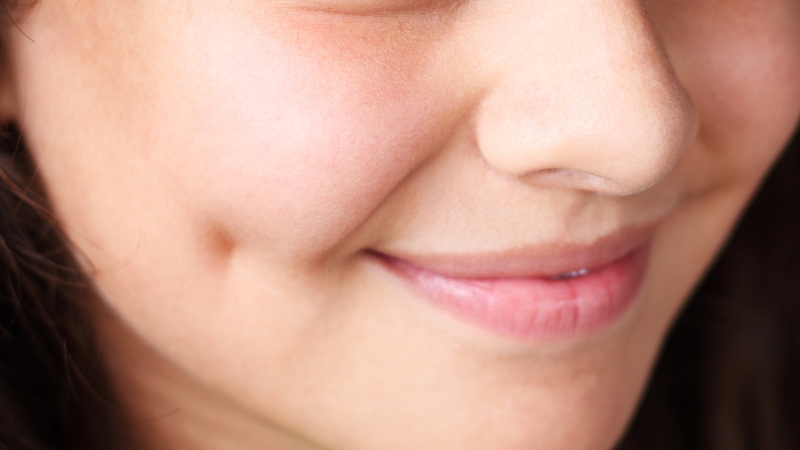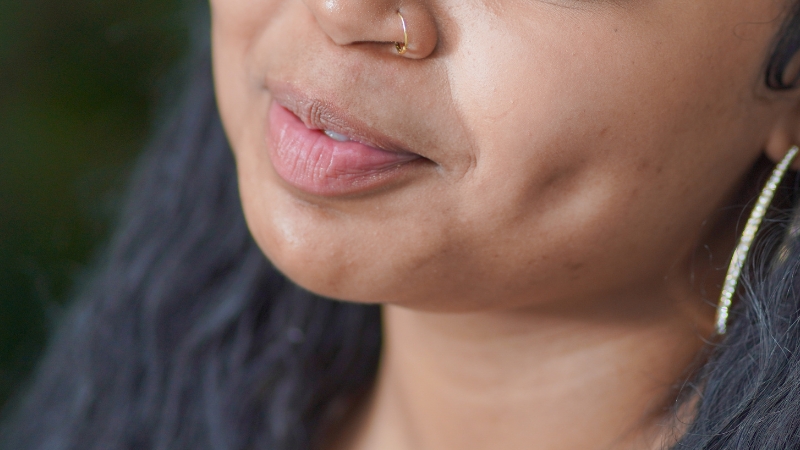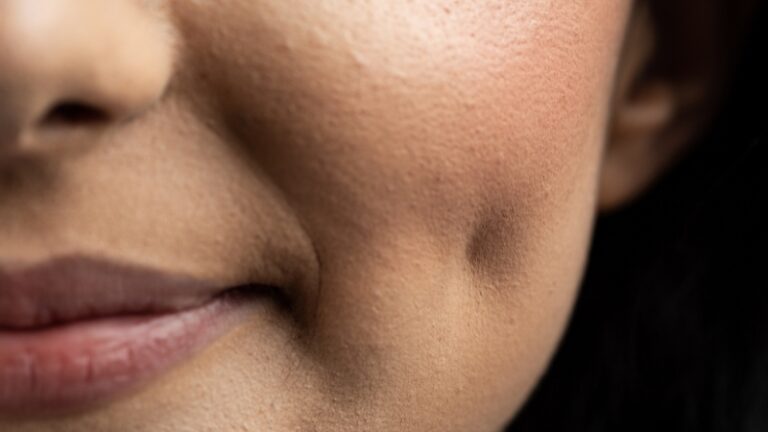Dimples are typically formed due to a variation in the structure of the zygomaticus major muscle, a muscle responsible for facial expressions.
In individuals with dimples, this muscle may split or be shortened, causing the skin above it to pull inward when they smile. This small muscle anomaly is what gives the cheek its distinct indentation.
Dimples can appear on one or both cheeks and sometimes on other parts of the body, such as the chin (cleft chin).
Genetically speaking, dimples are considered an autosomal dominant trait, meaning that only one parent needs to pass on the “dimple gene” for a child to inherit it.
However, this isn’t always consistent, and some people develop dimples later in life, sometimes temporarily, due to changes in body fat, muscle tone, or facial development during adolescence.
Are Permanent Non-Surgical Dimples Possible?

Let’s address the big question directly: There is no scientifically validated non-surgical method that can permanently create real dimples.
Dimples caused by surgery (dimpleplasty) or genetics result from a structural change in facial muscles and tissue, which non-invasive methods generally cannot replicate.
That said, there are several non-surgical techniques and lifestyle practices that may help enhance the appearance of dimples, either by creating a temporary illusion or promoting the possibility of subtle indentations over time.
The permanence and effectiveness of these methods vary widely and lack clinical evidence, but some people swear by them.
1. Dimple Exercises: Do They Work?
One of the most commonly suggested non-surgical techniques is dimple exercises. These involve repetitive facial movements designed to strengthen and manipulate the cheek muscles.
Popular dimple exercises include:
- Press and Hold Technique: Smile and press your index fingers into the spots where you want dimples. Hold the position for 30 minutes a day, or repeat in short intervals several times daily.
- Cheek Sucking Method: Suck your cheeks inward so that they rest against your teeth, then hold for 5–10 minutes a few times daily.
- Fish Face Exercise: Make a fish face by sucking in your cheeks and puckering your lips. Hold for 30 seconds, release, and repeat multiple times.
Do They Work?
While facial exercises can tone facial muscles and slightly alter appearance, no scientific studies confirm that these movements can create permanent dimples. Anecdotally, some people claim slight indentations appear after months of consistent practice, especially if they have thinner cheeks.
However, these are not structural dimples and will not remain when your face is relaxed.
2. Makeup Techniques: Creating the Illusion
View this post on Instagram
While makeup doesn’t make dimples permanent, it’s a practical way to mimic their appearance. Many professional makeup artists use shading and contouring to simulate dimples on the cheeks.
How to create fake dimples with makeup:
- Smile to locate the natural placement.
- Use a brown or taupe eyeliner or brow pencil to mark a small dot or line where the dimple would appear.
- Lightly blend the edges with a small brush to create a shadow effect.
- Optional: Add a small amount of highlighter above the shadow to make the illusion more natural.
Makeup is, of course, temporary, but it’s a safe and effective way to enjoy the aesthetic of dimples for events or photos without committing to surgery or long-term techniques.
3. Facial Weight and Dimples
In some cases, weight loss can make natural facial muscle structures more visible.
For people with a predisposition to dimples or slight muscle variations, losing facial fat may enhance these features.
However, this method depends entirely on individual genetics. Some people may notice slight natural indentations after weight loss, while others may not.
You should not attempt to lose weight solely to achieve dimples, especially if you’re already at a healthy body weight.
Facial fat distribution varies, and weight loss could have unpredictable effects on facial appearance.
4. Piercing-Based Methods (Dimple Piercings)
Although technically not “natural” or non-invasive, some people get dimple piercings to mimic the look of permanent dimples. These are dermal piercings placed in the cheek area, often at the same spot natural dimples would appear.
Once healed, the indent from the piercing can remain even if the jewelry is removed.
However, this approach comes with risks like infection, nerve damage, and permanent scarring. It’s not surgery, but it’s also not reversible or risk-free. If you’re considering this, consult with a professional and ensure proper hygiene and placement.
5. Face Taping or Suction Devices: Any Science?
On platforms like TikTok and YouTube, you may find creators using face-taping techniques or suction cups to “press” indentations into the cheeks. The idea is that long-term pressure can “train” the skin to form dimples.
However, there’s no medical evidence that applying pressure to the skin in this way will result in lasting anatomical changes.
Skin and muscle structures don’t form new permanent indentations simply due to external pressure, especially without underlying muscular changes.
These techniques may offer temporary marks or shadows, but they will not provide lasting results and can even irritate the skin or damage tissue over time.
What About Natural Genetic Expression?

Some individuals may develop dimples later in life, especially during puberty when facial muscles and fat shift. This is more common in people with a mild split in the zygomaticus major muscle or similar natural features that become visible over time.
If you think you might have a genetic predisposition (for example, a parent or sibling has dimples), subtle signs might appear with age or changes in facial structure.
That said, true natural dimples are either present from birth or develop early, and no known lifestyle change or exercise guarantees new ones will form later.
What Science and Experts Say About Creating Dimples Without Surgery
When it comes to the idea of getting permanent dimples without surgery, scientific evidence is clear and consistent: there’s currently no proven non-surgical method that can reliably or permanently create real dimples.
While there’s a lot of enthusiasm online for exercises, pressure techniques, and home remedies, experts in dermatology and facial anatomy urge people to understand how dimples actually form and why they’re so difficult to replicate artificially.
A 2018 study published in The Journal of Cosmetic Dermatology examined the origins of facial features like dimples and concluded that they are almost entirely determined by genetics.
Specifically, dimples result from an inherited variation in the underlying facial muscle structure. In most cases, this involves a split or duplication in the zygomaticus major muscle, which causes the overlying skin to indent when the muscle contracts, usually while smiling.
This muscular difference is either present from birth or develops naturally, often influenced by genetic inheritance patterns. Because of this, researchers emphasized that there is no scientific basis for the idea that dimples can be created permanently through exercises or external pressure.
Another source of insight comes from a comprehensive review of facial muscle anatomy published in Plastic and Reconstructive Surgery, one of the most respected medical journals in the field.

The review confirmed that the specific muscle configuration responsible for natural dimples is a rare anatomical variant, not a feature that can develop in response to movement, pressure, or training.
According to the findings, external manipulation—whether through pressing, taping, or facial workouts—cannot change muscle structure in a way that would lead to permanent dimples.
Additionally, leading dermatologists and facial plastic surgeons broadly agree on one key point: the only consistent, medically recognized method for creating permanent dimples is dimpleplasty.
Dimpleplasty is a minimally invasive surgical procedure in which a small incision is made inside the cheek and a stitch is placed to connect the skin with the underlying muscle. This technique effectively mimics the natural dimple formation mechanism and results in a long-lasting, visible indentation.
The procedure is usually performed under local anesthesia and requires minimal recovery time, making it a popular option for those committed to having dimples.
Final Thoughts
If you are hoping to get dimples permanently without surgery, it’s important to have realistic expectations. Most natural or non-invasive methods cannot replicate the muscular and structural changes that cause genuine dimples.
That doesn’t mean you can’t enhance your natural features, create a similar look, or enjoy the appearance temporarily, but permanent results without surgical intervention are not supported by science at this time.
Similarly, while dental implants offer a long-lasting solution for missing teeth, they come with both benefits and potential challenges that should be carefully considered before making a decision.
For those who prefer not to undergo surgery, experimenting with facial exercises, makeup techniques, and learning to enhance other features might be a better, safer, and more fulfilling alternative.

